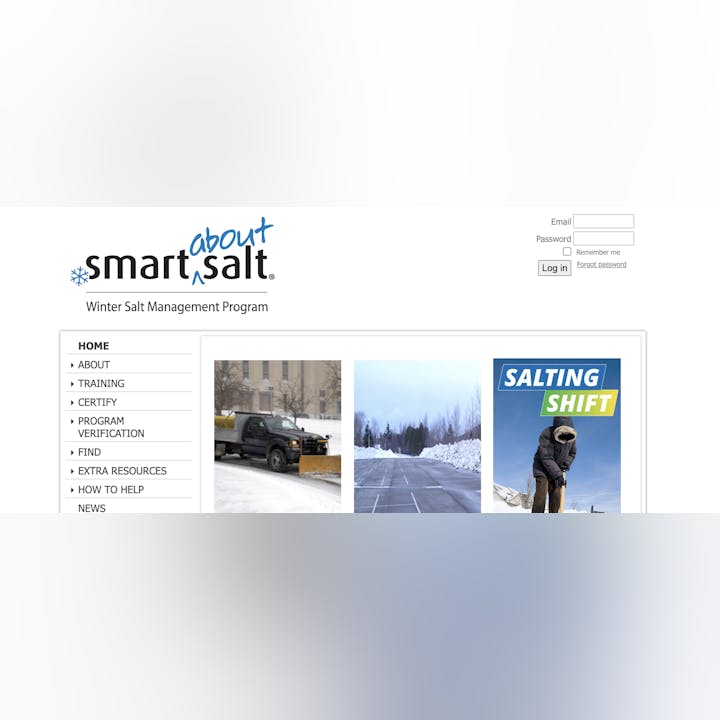Low Salt, No Salt MN

Help us spread the word about chloride pollution in our waters.
Overuse of deicers for winter maintenance is a growing problem for Minnesota lakes, ponds, wetlands, streams, and groundwater.
The leading source of chloride pollution is from deicing chemicals (e.g. winter salt) used in winter maintenance. Chloride damages property and the environment, harms aquatic species, and impacts drinking water quality. About 50 waterbodies in Minnesota already have dangerous chloride levels, and another 75 waterbodies are close to the danger zone. Learn more about chloride pollution from the Minnesota Pollution Control Agency (MPCA).
Once chloride is in a waterbody, there is no feasible way to remove it, and it takes only one teaspoon of salt to permanently pollute five gallons of water. Further, the alternatives to chloride have other tradeoffs in cost, environmental impacts, and service. Therefore, the leading strategy for managing chloride pollution is to be smart about its use; applying it only when, where, and in the amount needed. This also means that every effort, big or small, helps reduce chloride pollution!
How do we get people to reduce their use of deicers?
Many people believe protecting water resources is important and that education fosters positive attitudes about reducing salt use. But education about chloride pollution, by itself, may not be enough to get people to change their winter salting routines.
The biggest reason people oversalt is fear of slip-and-fall lawsuits. When talking to someone about reducing their winter salt use, emphasize that they can absolutely maintain safety while realizing cost savings and environmental protection.
People may be unsure of how best to reduce chloride use on their properties or how to address concerns about safety or liability. You can step into this void by offering a friendly face and simple advice, and you can direct them to your local watershed district or city water resources staff for more site specific information. Check out Frequently Asked Questions.
The Toolbox
Use this set of resources for talking to others about chloride pollution.
PowerPoint Presentation
Download the Presentation (40 MB)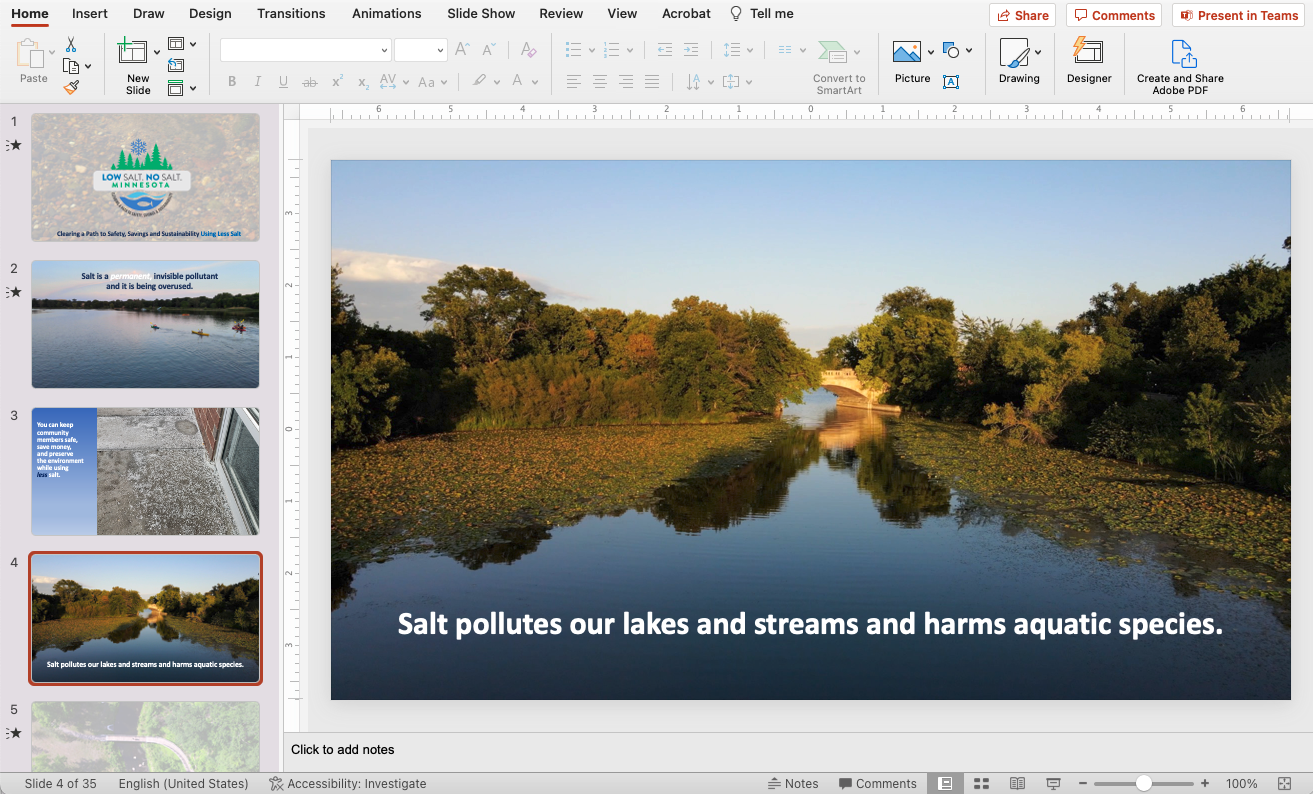
Suggested uses
Customize the presentation for your organization and your audience:
- Add your logo
- Include your contact information
- Add your own slides
- Remove non-relevant slides
Full video (4 min 45 sec)
Social media version of video (40 seconds)
Liability and winter maintenance planning (2 min 34 sec)
Suggested uses
- Share video link through email
- Show video during a virtual or in-person presentation or event
- Share a video through social media
- Embed on your website (open video YouTube link, click "Share", select "Embed" to view and copy code for inserting onto website
Questions to Begin a Conversation about Reducing Chloride Use
Ice-breaker questions
- Introductions. What is your name, how long have you lived/worked/worshipped here?
- Are you on a board or committee for this place?
- Who has been involved in winter maintenance?
- What do you love about the place where you live/work/worship?
Site assessment questions
- What are your known problem areas? How are you managing them currently? How would you like them to be managed?
- Do you have a written plan with protocols for winter maintenance? If so, are you following the plan?
- Do you hire a service provider or is the service provided by ‘in-house’ maintenance or management staff? If it’s hired out, do you know who your service provider is? Are they Smart Salting certified?
- Tell us about your common areas. Do you have a salt bucket/shovel/ice pick in a common area entrance?
- Is salt stored at your property? Where?
- Do you regularly communicate with your customers/residents/parishioners about winter maintenance operations and snow/ice hazards?
- Do you have a history of slip and fall accidents?
- Where do you get the most complaints for too little or too much salt?
- Do you have any drainage-related problem areas?
- Do you have any snow storage related problem areas?
- Are there any areas that are seasonally closed or could be seasonally closed? (Keep in mind emergency exits)
- What do you think is low hanging fruit for smarter salt use?
- Is there anything you’d like us to see?
General discussion questions
- What’s your reaction to the video? To the presentation?
- What was surprising?
- What did you already know?
- How does this relate to your property?
- What is working well regarding winter maintenance?
- What is not working well regarding winter maintenance?
- Can you think of an example in your community where winter maintenance is done well? Where it could be improved?
Suggested uses
- Use these questions during your presentation or other conversation with someone about reducing use of winter de-icers.
Pledge Form
Download the Take the Pledge form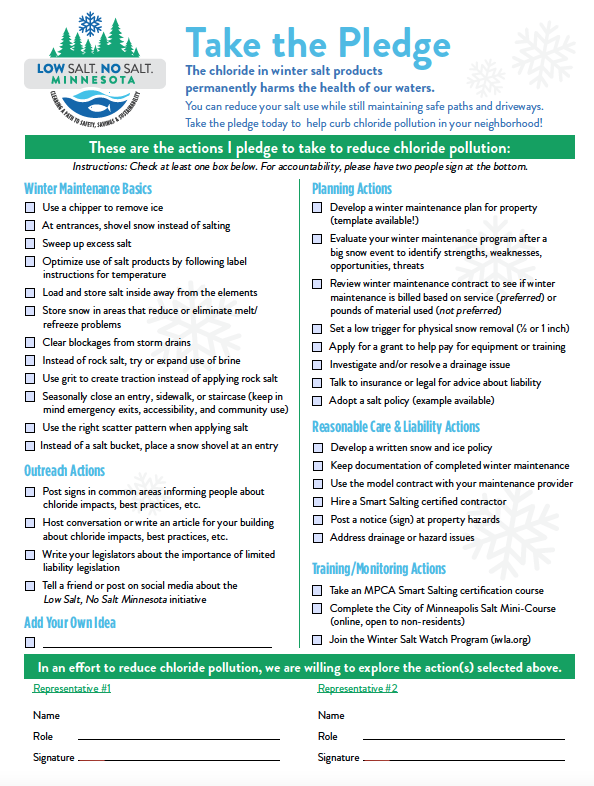
Giveaway
Giveaways can help boost your audience's committment to reducing salt use. A limited number of long-handled, commercial-grade ice scrapers are available from the Low Salt, No Salt program for LGUs in Hennepin County to use as a giveaway in your outreach efforts. For more information, email LForbes@rpbcwd.org.
Suggested uses
- Offer the pledge form at community events where you are tabling
- After a presentation related to water quality, ask audience members to sign the pledge
- Email the pledge directly property managers, homeowner associations, and others
Logo
There are five versions of the logo to meet your desired use:
Note: White/gray and white logos will not have background color when you download.
Suggested uses
- Consider using the branding style guide when making your own handouts about chloride pollution.
- Add the Low Salt, No Salt Minnesota logos to your website
- Use the logos when sharing chloride pollution information on social media.
Frequently Asked Questions
Your community may have questions about chloride pollution. The Frequently Asked Questions Handout answers some of the most common ones.
Frequently Asked Questions Handout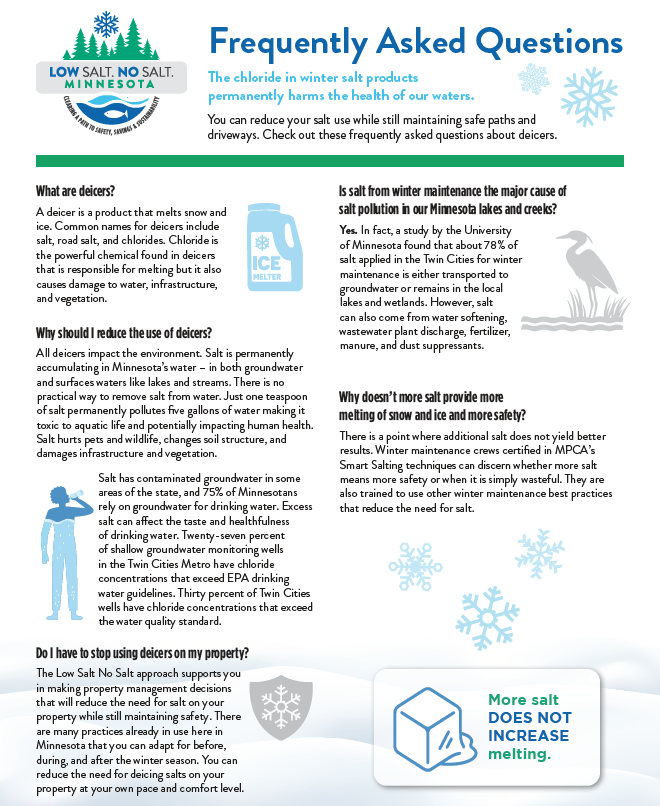
Suggested uses
- Review handout to be prepared for questions.
- Provide handout to community members.
You can print these cards yourself or send the PDF file to a printing company. The second side has space to add your own contact information or logo.
Download the double two-per-page, two-side card suitable for printing on 8.5"x11" paper or cardstock.Download the single two-sided card. Sized to print at 5.5"x8.5".
Download the single two-sided card with 0.125" bleed. Sized to print at 5.5" x 8.5".
Note: Having a bleed allows extra 0.125" for trimming (color bleeds beyond margin for more finished look) by a professional printing company.
Download EPS versions of the above files on the Low Salt No Salt MN Google Drive. Each image is a separate EPS file labeled "side 1" or "side 2" with descriptor (double, single, bleed).
Front side and back side of card shown beow. Back side has space to add your own info or logo.
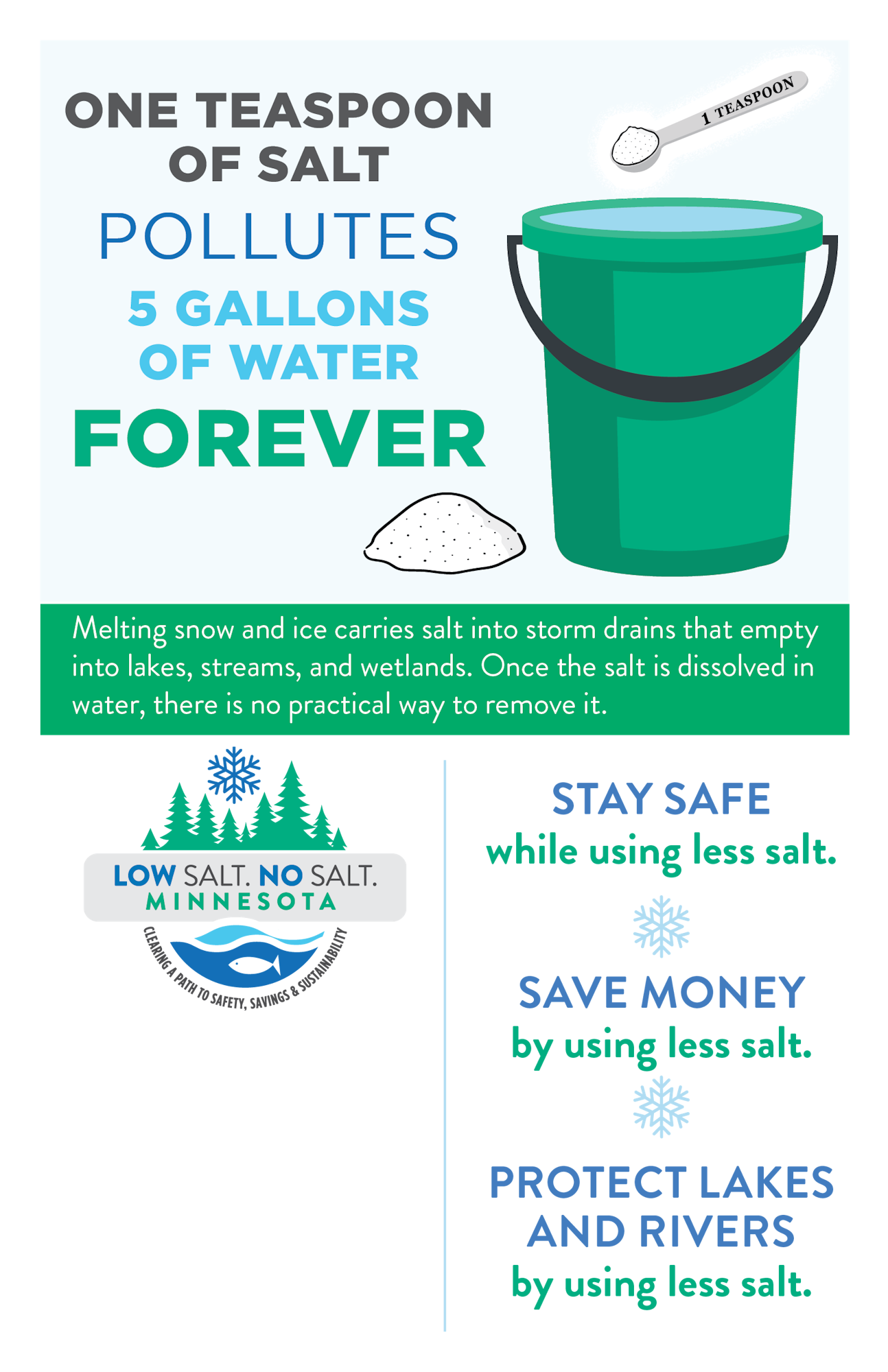
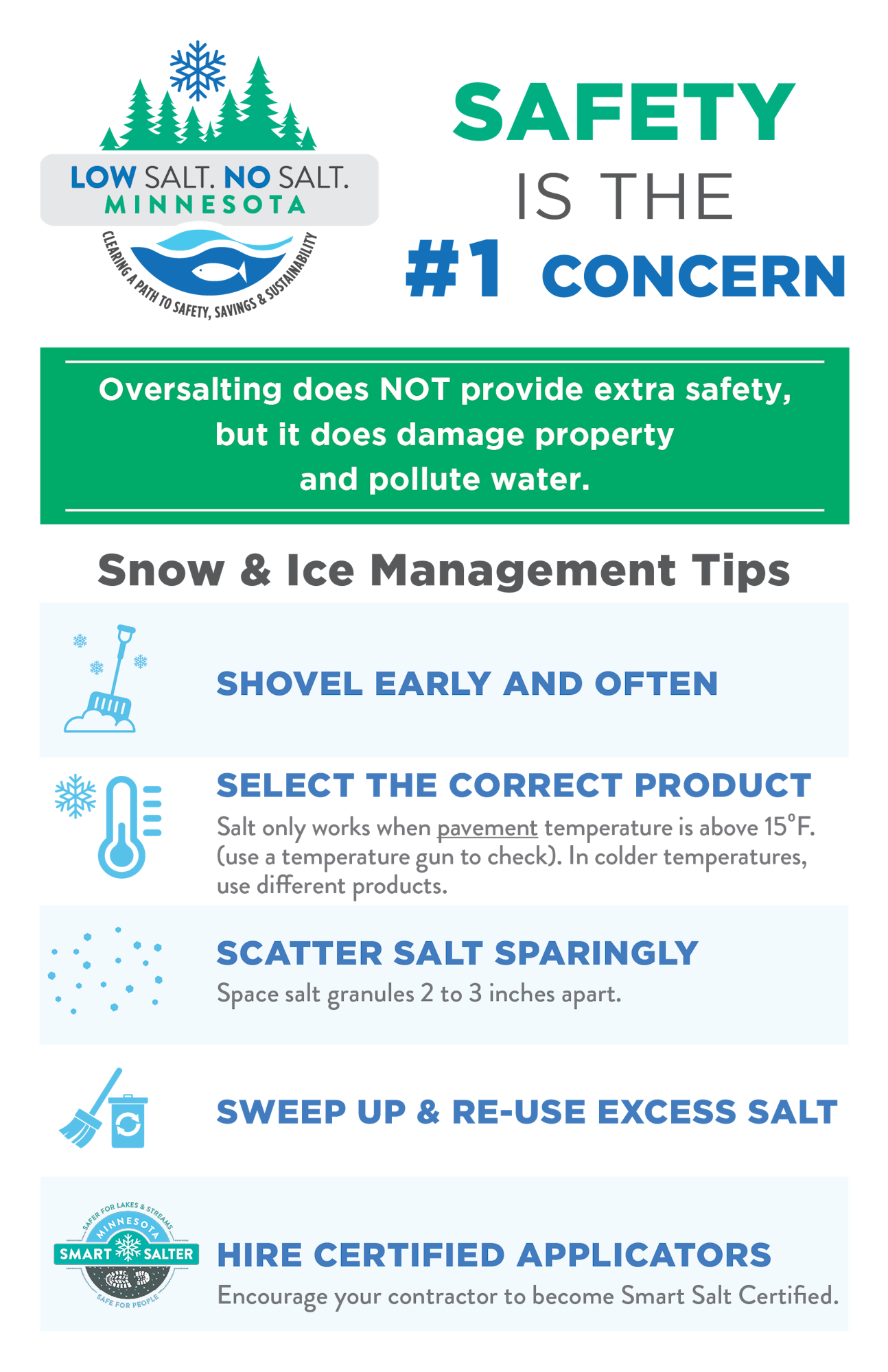
Suggested uses
- Print to have on hand when you're out in the community.
- Handout at events or meetings.
- Use pieces of graphic on social media.
Audience Considerations
Winter Maintenance Contractors
On large developed properties, winter maintenance is typically performed by private contractors. Many contractors already know that chloride can pollute water, however, their clients demand more salting due to concerns about slip and fall liability.
Commercial Properties
Large retailers such as malls and big box stores typically contract their winter maintenance. If you're out shopping and see a lot of winter salt, voice your concerns respectfully to the store manager and direct them to the watershed district or city water resources staff for more information.
Templates for Property Managers
Share these with people you know who are responsible for making property management decisions. This may include your homeowners association board, leaders in your community of faith, and workplace building manager. Or consider inviting watershed district staff or city water resources staff to talk with these decision makers.
Model Winter Maintenance Contract
Sharing knowledge from others is a great way to help others reduce their winter salt use. The City of Edina developed a model contract for snow and ice management that embraces best practices to minimize environmental impacts from salt and other chemicals. Property owners can adapt the model contract to suit their needs and to ensure their contractors are protecting Minnesota waters from chloride pollution.
Minnesota Model Contract for Snow and Ice Management (pdf)Cover Letter (pdf)
Explanatory Memo (pdf)
Winter Site Maintenance Templates
Share these with people in your community looking for information about developing a winter maintenance plan. Three templates are scaled to meet user needs:
Basic Winter Maintenance Plan Template Intermediate Winter Maintenance Plan Template Detailed Winter Maintenance Plan TemplateDownload the calculator below to help determine which template would be best.
Calculator for Choosing a Winter Maintenance Template
Download the calculator (Excel file) that will help users select a winter site maintenance template.Other Resources
There are a lot of great websites out there with resources ready to use in your chloride reduction efforts. Check out these:








